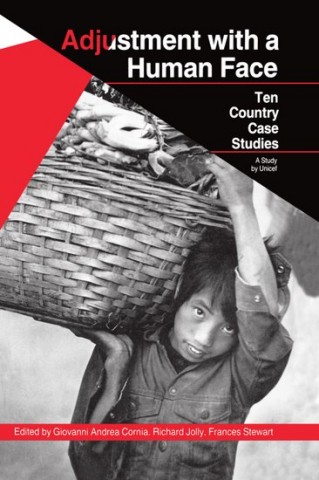Anyone who has taken a development studies class has most likely heard about the failure of the Structural Adjustment Programs (SAPs). Indeed, these programs caused significant harm to the most vulnerable in society. Yet, far too often students are only given a brief summary supported by carefully selected examples (that the World Bank is bad is is a typical lesson passed on in many critical development studies courses). For anyone interested in the SAPs, and keen to know more of the context, "Adjustment with a Human Face" (1987) edited by Cornia, Jolly and Steward is well worth finding a copy of. Volume 1 covers thematic issues, while Volume 2 presents ten country case studies.
The terms: "'Adjustment with a human face' is the name we have given to the range of economic and other policy measures which we believe are needed. 'Adjustment' indicates that for most of the developing countries, these policies must be part and parcel of the national 'adjustment' policies widely adopted to tackle the economic crisis facing these countries - the acute deficits in the balance of payments and the government budget, also often rapid inflation rates and negligible or negative economic growth. 'The human face' indicates the need for the human implications of an adjustment policy to be made an integral part of adjustment policy as a whole, not to be treated as an additional welfare component." (p. 2). The study presents useful context for the SAPs; climate-related challenges, economic downturn, fiscal challenges - adjustment was required. It was, the authors note, "the most severe and prolonged recession since the 1930s" (p. 287).
Unlike what may critical development studies courses teach, it was not the SAPs that were the primary cause, but the global economic downturn, the negative impacts of which were worsened by SAPs: "we recognize that the primary cause of the downward economic pressures on the human situation in most of the countries affected is the overall economic situation, globally and nationally, not adjustment policy as such. Indeed, without some form of adjustment, the situation would often be far worse." (p. 5). However, that is not an endorsement of SAPs, in fact it is the opposite: "to recognize that adjustment is necessary for dealing with severe economic imbalances in an economy is not the same as accepting that all adjustment policies are or have been equally adequate for ensuring adjustment to a more growth-oriented pattern of development, in which the human needs of the vulnerable will be protected in the short as well as the medium to long term" (p. 6).
"The evidence shows that while adverse climatic changes, particularly in 1983-84 and in Africa, have been important compounding factors, in almost every case deterioration in child welfare resulted in large part from the economic decline of the 1980s and from the lack of appropriate policies aimed at protecting children" (p. 35). Furthermore, the book demonstrates "the inadequacy of conventional approaches to adjustment from the perspective of protecting the vulnerable and promoting growth. In many countries, the position of the poor has worsened during adjustments, with deterioration in nutrition levels and education achievements of children. Moreover, investment rates have frequently also slowed or fallen. With reduced expenditure on both human and physical resources, the prospects for economic growth in the medium term have worsened. It is clear that alternative adjustment packages are needed" (p. 131).
"Most of these adjustment programs did not reverse the adverse developments in the conditions of children, nor, in many cases, did they lead to resumed economic growth. Conditions of children continued to worsen in many countries. While there are many causes of the deteriorating conditions - including the adverse course of the world economy and many weaknesses in national policies - it appears that the type of adjustment policies adopted have been an important contributory element in many cases" (p. 288).
It is well worth noting the countries used as case studies: Botswana, Brazil, Chile, Ghana, Jamaica, Peru, Philippines, South Korea, Sri Lanka and Zimbabwe. A number of the selected developing nations from the 1970s and 1980s have since become middle- or high-income nations (why these ten case studies were selected is not clear). These detailed case studies will be useful sources of information for students looking for historical context on a particular country.

